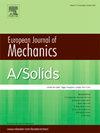Study on residual stress of 1J22 alloy in longitudinal-torsional ultrasonic milling: modeling and multi-scale simulation
IF 4.2
2区 工程技术
Q1 MECHANICS
引用次数: 0
Abstract
Surface microcracks and residual tensile stresses usually occur on the machined 1J22 alloy surface due to its inherent brittleness. Longitudinal torsional ultrasonic-assisted milling (LTUM) is an effective technique for achieving high-precision, low-stress machining of brittle metallic materials. To elucidate the mechanistic influence of LTUM on residual stress in 1J22 alloy, a residual stress analytical model was developed that considers the thermo-mechanical coupling. The surface residual stress of the 1J22 alloy was investigated through a multi-scale approach that integrates molecular dynamics simulation, finite element modeling, and LTUM experiment. The findings indicate that the theoretical model aligns closely with empirical measurements, with an average deviation of 2.13 %. The dislocation line length of LTUM is reduced by 16.6 % at most, which reduces dislocation concentration and reduces crack damage. In the LTUM experiment, the average cutting force and cutting temperature decrease by 11 % and 8 %, respectively. The residual compressive stress increases by 10.7 %. Ultrasonic energy reduces stress concentration by activating dislocation migration and inhibiting fracture on the alloy's surface. This paper provides valuable insights into the formation mechanisms of residual stress during the cutting process of 1J22 alloy, facilitating the advancement of high-accuracy engineering applications for such materials.
1J22合金纵扭超声铣削残余应力研究:建模与多尺度仿真
由于1J22合金本身的脆性,其加工表面通常会产生微裂纹和残余拉伸应力。纵向扭转超声辅助铣削是实现脆性金属材料高精度、低应力加工的有效技术。为了阐明LTUM对1J22合金残余应力影响的机理,建立了考虑热-力耦合的残余应力分析模型。采用分子动力学模拟、有限元建模和LTUM实验相结合的多尺度方法研究了1J22合金的表面残余应力。结果表明,理论模型与实证测量结果吻合较好,平均偏差为2.13%。LTUM的位错线长度最大减小了16.6%,减少了位错集中,减小了裂纹损伤。在LTUM实验中,平均切削力和切削温度分别降低了11%和8%。残余压应力提高了10.7%。超声能通过激活位错迁移和抑制合金表面断裂来降低应力集中。本文对1J22合金切削过程中残余应力的形成机制提供了有价值的见解,有助于推进该材料的高精度工程应用。
本文章由计算机程序翻译,如有差异,请以英文原文为准。
求助全文
约1分钟内获得全文
求助全文
来源期刊
CiteScore
7.00
自引率
7.30%
发文量
275
审稿时长
48 days
期刊介绍:
The European Journal of Mechanics endash; A/Solids continues to publish articles in English in all areas of Solid Mechanics from the physical and mathematical basis to materials engineering, technological applications and methods of modern computational mechanics, both pure and applied research.

 求助内容:
求助内容: 应助结果提醒方式:
应助结果提醒方式:


